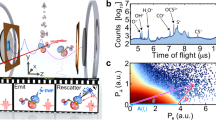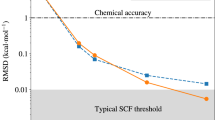Abstract
Using a novel iterative structure factor retrieval algorithm, here I show that electron density can be directly calculated from solution scattering data without modeling. The algorithm was validated with experimental data from 12 different biological macromolecules. This approach avoids many of the assumptions limiting the resolution and accuracy of modeling algorithms by explicitly calculating electron density. This algorithm can be applied to a wide variety of molecular systems.
This is a preview of subscription content, access via your institution
Access options
Access Nature and 54 other Nature Portfolio journals
Get Nature+, our best-value online-access subscription
$29.99 / 30 days
cancel any time
Subscribe to this journal
Receive 12 print issues and online access
$259.00 per year
only $21.58 per issue
Buy this article
- Purchase on Springer Link
- Instant access to full article PDF
Prices may be subject to local taxes which are calculated during checkout



Similar content being viewed by others
References
Miao, J., Sayre, D. & Chapman, H.N. J. Opt. Soc. Am. A Opt. Image Sci. Vis. 15, 1662–1669 (1998).
Maleki, M.H. & Devaney, A.J. J. Opt. Soc. Am. A 10, 1086–1092 (1993).
Fienup, C. & Dainty, J. In Image Recovery: Theory and Application 231–275 (1987).
Zuo, J.M., Vartanyants, I., Gao, M., Zhang, R. & Nagahara, L.A. Science 300, 1419–1421 (2003).
Millane, R.P. JOSA A 7, 394–411 (1990).
Donatelli, J.J., Zwart, P.H. & Sethian, J.A. Proc. Natl. Acad. Sci. USA 112, 10286–10291 (2015).
Yefanov, O.M. & Vartanyants, I.A. Eur. Phys. J. Spec. Top. 167, 81–86 (2009).
Svergun, D.I. & Stuhrmann, H.B. Acta Crystallogr. A 47, 736–744 (1991).
Svergun, D.I. Biophys. J. 76, 2879–2886 (1999).
Walther, D., Cohen, F.E. & Doniach, S. J. Appl. Cryst. 33, 350–363 (2000).
Henderson, S.J. Biophys. J. 70, 1618–1627 (1996).
Chacón, P., Morán, F., Díaz, J.F., Pantos, E. & Andreu, J.M. Biophys. J. 74, 2760–2775 (1998).
Tuukkanen, A.T., Kleywegt, G.J. & Svergun, D.I. IUCrJ 3, 440–447 (2016).
Putnam, C.D., Hammel, M., Hura, G.L. & Tainer, J.A. Q. Rev. Biophys. 40, 191–285 (2007).
Fienup, J.R. Opt. Lett. 3, 27–29 (1978).
Marchesini, S. et al. Phys. Rev. B 68, 140101 (2003).
Grant, T.D. et al. Biopolymers 95, 517–530 (2011).
Petoukhov, M.V., Weissenhorn, W. & Svergun, D.I. Front. Mol. Biosci. 1, 20 (2014).
Svergun, D.I. & Koch, M.H.J. Rep. Prog. Phys. 66, 1735 (2003).
Rambo, R.P. & Tainer, J.A. Biopolymers 95, 559–571 (2011).
Rambo, R.P. & Tainer, J.A. Nature 496, 477–481 (2013).
Gerchberg, R.W. & Saxton, W.O. Optik (Jena) 35, 237 (1972).
Schmidt-Rohr, K. J. Appl. Cryst. 40, 16–25 (2007).
Glatter, O. J. Appl. Cryst. 10, 415–421 (1977).
Moore, P. J. Appl. Cryst. 13, 168–175 (1980).
Svergun, D. J. Appl. Cryst. 25, 495–503 (1992).
Porod, G. Kolloid-Zeitschrift 124, 83–114 (1951).
Schneidman-Duhovny, D., Hammel, M., Tainer, J.A. & Sali, A. Biophys. J. 105, 962–974 (2013).
Galaz-Montoya, J.G. et al. J. Struct. Biol. 194, 383–394 (2016).
Grigorieff, N. Acta Crystallogr. D Biol. Crystallogr. 56, 1270–1277 (2000).
Pettersen, E.F. et al. J. Comput. Chem. 25, 1605–1612 (2004).
Volkov, V.V. & Svergun, D.I. J. Appl. Cryst. 36, 860–864 (2003).
Elser, V. & Millane, R.P. Acta Crystallogr. A 64, 273–279 (2008).
Wriggers, W. Acta Crystallogr. D Biol. Crystallogr. 68, 344–351 (2012).
The PyMOL Molecular Graphics System v. 1.8. (Schrödinger, LLC, 2015).
Acknowledgements
The author is grateful to W. Bauer, J. Chen, R. Kirian, E. Lattman, E. Snell and J. Spence for discussions and review of the manuscript. Financial support was provided by the BioXFEL NSF Science and Technology Center (NSF 1231306).
Author information
Authors and Affiliations
Corresponding author
Ethics declarations
Competing interests
The author declares no competing financial interests.
Integrated supplementary information
Supplementary Figure 1 Fourier shell correlation curves using experimental SAXS data
Fourier shell correlation (FSC) curves are shown for each of the twelve samples shown in Figures 2 and 3. The solid black curve (—) shows the FSC comparing the averaged maps from the even versus odd halves of the set of ab initio SAXS densities. The dashed curve (---) shows the FSC comparing the averaged SAXS density to the density simulated from the known atomic model. Horizontal dashed lines represent the cutoff used for estimating resolution at 0.5.
Supplementary Figure 2 Electron density maps calculated from models and simulated SAXS data for samples 1 through 11
(a) Electron density maps calculated from atomic coordinates. Electron density was calculated using Chimera to a resolution indicated in parentheses. (b) Electron density maps reconstructed from simulated SAXS data using DENSS. Simulated SAXS profiles were calculated using FoXS to the maximum q value from experiment (Supplementary Table 1). Electron densities are shown as volumes colored according to density (color bar indicates electron density values in e−/Å3).
Supplementary Figure 3 Electron density maps calculated from models and simulated SAXS data for sample 12
(a) Electron density maps calculated from atomic coordinates. Electron density was calculated using Chimera to a resolution indicated in parentheses. (b) Electron density maps reconstructed from simulated SAXS data using DENSS. Simulated SAXS profiles were calculated using FoXS to the maximum q value from experiment (Supplementary Table 1). Electron densities are shown as volumes colored according to density (color bar indicates electron density values in e−/Å3).
Supplementary Figure 4 Fourier shell correlation curves using simulated SAXS data
Fourier shell correlation (FSC) curves are shown for each of the twelve samples shown in Supplementary Figures 2b and 3b using simulated SAXS data calculated from atomic models with FoXS. The solid black curve (—) shows the FSC comparing the averaged maps from the even versus odd halves of the set of ab initio SAXS densities. The dashed curve (---) shows the FSC comparing the averaged SAXS density to the density simulated from the known atomic model. Horizontal dashed lines represent the cutoff used for estimating resolution at 0.5.
Supplementary Figure 5 Reconstructions from simulations of cylinders of varying aspect ratios
SAXS profiles from three homogenous cylinders of aspect ratio 2:1 (left), 5:1 (middle), and 10:1 (right) were simulated. Each cylinder has a length of 100 Å. The bottom row shows the same objects as in the top row rotated by 90 degrees. For each aspect ratio, the original density is shown on the left, the average of 100 reconstructions generated by DENSS using default parameters is shown in the middle, and the average of ten bead models built by DAMMIF is shown on the right. Densities are shown as volumes colored according to density, and bead models are shown as gray surfaces.
Supplementary Figure 6 Reconstructions using simulated SAXS profiles from a set of protein structures of complex shapes
SAXS profiles from three high-resolution protein structures with complex shapes were calculated from the coordinates deposited in the PDB using FoXS. Each row corresponds to one protein structure using PDB codes 2RCJ (top row), 1A0S (middle row) and 1IC1 (bottom row). The left two columns show averaged density reconstructions from DENSS (rotated 90 degrees relative to one another). The right two columns show the averaged bead models calculated with DAMMIF (rotated 90 degrees relative to one another). Electron density maps are displayed as volumes colored according to density. Bead models are shown as transparent gray surfaces. Reconstructions are shown overlapped by the high-resolution structures in green space-filling (2RCJ) or black cartoon (1A0S, 1IC1) representations.
Supplementary Figure 7 Reconstructions using SAXS data from spheres of various density gradients
Rows correspond to four varieties of electron density gradients from spheres of radius 25 Å. The column labeled “Original” shows the original density used to calculate the SAXS profile. The columns labeled “Single Reconstruction” and “Average” show the results from DENSS for a single reconstruction and average of twenty reconstructions, respectively. The column labeled “Bead Model” shows the average of ten bead models using DAMMIF. Electron densities are shown as volumes colored according to density. Bead models are shown as gray wire mesh to facilitate visualization of internal structure such as cavities.
Supplementary Figure 8 Single reconstructed electron density maps using experimental SAXS data for samples 1 through 11
Electron density maps for a randomly selected single reconstruction from experimental SAXS data for samples 1 through 11 corresponding to Figure 2. Electron densities are shown as volumes colored according to density (color bar indicates electron density values in e−/Å3).
Supplementary Figure 9 Ten single reconstructed electron density maps using experimental SAXS data from sample 12
Electron density maps for ten randomly selected single reconstructions from experimental SAXS data for sample 12 corresponding to Figure 3. Electron densities are shown as volumes colored according to density (color bar indicates electron density values in e−/Å3).
Supplementary Figure 10 Previously published bead model reconstructions using experimental SAXS data for samples 1 through 12
Figures reprinted with permission. Published ab initio bead models calculated from experimental SAXS data. Note that the sample numbering has been changed to correspond to the current manuscript, and the ordering and image layout is similar to facilitate comparison. The left side corresponds to samples 1 through 11 shown in Fig. 2 and shows high resolution crystal structures (cartoon representation) overlaid onto averaged bead models (transparent gray surface)17. The right side corresponds to sample 12 shown in Fig. 3 and shows the bead model (gray spheres) overlaid on the atomic model (red spheres and blue ribbon)18.
Supplementary information
Supplementary Text and Figures
Supplementary Figures 1–10, Supplementary Tables 1–3 and Supplementary Notes 1–5 (PDF 2909 kb)
Supplementary Protocol
DENSS installation and usage instructions (PDF 178 kb)
Convergence process of electron density reconstruction from SAXS data
This video shows the convergence process for a single ab initio electron density reconstruction from SAXS data using the software DENSS for sample 11. Electron density is displayed as a volume object colored according to density. The top right graph shows the fit of the calculated scattering profile (red circles) to the smooth (black line) and raw (black circles) experimental data. After convergence is achieved, the known high-resolution atomic coordinates are superimposed to the density, shown in cartoon representation. (MOV 31120 kb)
Rights and permissions
About this article
Cite this article
Grant, T. Ab initio electron density determination directly from solution scattering data. Nat Methods 15, 191–193 (2018). https://doi.org/10.1038/nmeth.4581
Received:
Accepted:
Published:
Issue Date:
DOI: https://doi.org/10.1038/nmeth.4581
This article is cited by
-
ATP-dependent conformational dynamics in a photoactivated adenylate cyclase revealed by fluorescence spectroscopy and small-angle X-ray scattering
Communications Biology (2024)
-
A hemoprotein with a zinc-mirror heme site ties heme availability to carbon metabolism in cyanobacteria
Nature Communications (2024)
-
Disordered regions in proteusin peptides guide post-translational modification by a flavin-dependent RiPP brominase
Nature Communications (2024)
-
Legionella metaeffector MavL reverses ubiquitin ADP-ribosylation via a conserved arginine-specific macrodomain
Nature Communications (2024)
-
Characterization of mRNA Lipid Nanoparticles by Electron Density Mapping Reconstruction: X-ray Scattering with Density from Solution Scattering (DENSS) Algorithm
Pharmaceutical Research (2024)



